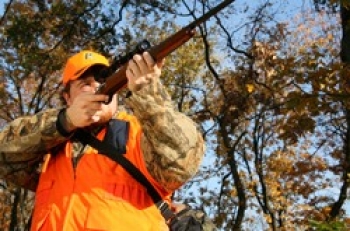Big Game Hunting in Tennessee

Big game animals include deer, turkey, bear, and elk
Fluorescent Orange: Hunters must wear on the upper portion of their body and head a minimum of 500 square inches of daylight fluorescent orange (blaze orange), visible front and back while hunting big game except on archery-only and turkey hunts. A hat and vest fulfill the requirements. Blaze orange camo is legal if it contains 500 square inches of fluorescent orange. In those areas where the archery-only deer season dates overlap with another big game gun season (i.e., bear) archers are required to wear 500 square inches of daylight fluorescent orange.
Field Dressing Big Game: Evidence of species or sex of big game animals and antlered status (if applicable) must not be destroyed and remain with the animal while afield. Normal field dressing, quartering, and icing down of the meat are permitted. Turkeys must remain intact until tagging and check-in are complete.
Big Game Found Dead: All big game found dead should be left where found and do not need to be reported unless someone wants the game for personal use or consumption. Persons wanting to possess big game, except bears, accidentally killed by a motor vehicle for personal use or consumption are required to notify TWRA or a local law enforcement agency within 48 hours. Personal possession of a bear accidentally killed by a motor vehicle is only lawful once a TWRA enforcement officer issues a possession tag for it. Reporting of sick deer or deer behaving strangely is not required, but it is encouraged. Reports may be made at tn.gov/twra/sickdeer.
Any vehicle in which an illegally possessed big game animal is found is subject to confiscation.
Albino Deer: Hunting, trapping, or possession of albino deer is prohibited as set forth in TCA 70-4-130. An albino deer is a deer with a lack, or significant deficiency, of pigment in the skin and hair, and has pink eyes.
Mississippi River Flood Closure: When the Mississippi River at Caruthersville gauge reaches 34 ft. all big game hunting will close in the Mississippi River Floodwaters Zone (on private and public land) and will remain closed until the Mississippi River drops below 34 ft. at the Caruthersville gauge.
Check out the Regulations for hunting on Wildlife Management Areas (WMAs)
Summer feeding of deer could be hurting turkeys.
Consider abstaining from summer wildlife feeding. We all are aware that wild turkey numbers have been in decline across the Southeast US. Research has confirmed that declining populations are primarily due to poor reproduction and recruitment, not over-harvest. Supplemental feeding of wildlife, which has grown as a common practice in Tennessee and elsewhere, may be contributing to these declines.
Wildlife managers are concerned that corn put out for deer, especially during the summer, is hurting turkey numbers. A fungus called Aspergillus flavus grows in feed exposed to hot, humid conditions. This fungus produces toxins, known as aflatoxins, that are highly toxic to game birds, especially turkey poults and quail. New research has shown that in the summer, aflatoxin levels in feed can reach deadly levels to wild turkeys after only a few days (read the full report at: https://doi.org/10.7589/JWD-D-21-00052.)
Besides the risk of aflatoxin poisoning, other consequences to wild turkeys from feeding wildlife may include:
• Boosting population numbers of small mammal nest predators;
• Concentrating nest predators near nesting sites and brooding cover which may lead to higher predation rates;
• Unnaturally concentrating game animals (e.g., deer and turkeys) which increases the chances of disease outbreaks and spread.
Please consider these potential unintended consequences as you make decisions about wildlife feeding, especially during the hot, humid summer months. Contact Regional offices with questions.
